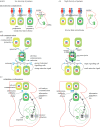Microchimerism as a source of information on future pregnancies
- PMID: 37608718
- PMCID: PMC10445024
- DOI: 10.1098/rspb.2023.1142
Microchimerism as a source of information on future pregnancies
Abstract
Small numbers of fetal cells cross the placenta during pregnancy turning mothers into microchimeras. Fetal cells from all previous pregnancies accumulate forming the mother's fetal microchiome. What is significant about microchimeric cells is that they have been linked to health problems including reproductive and autoimmune diseases. Three decades after the discovery of fetal microchimerism, the function of these cells remains a mystery. Here, we contend that the role of microchimeric cells is to inform the fetus about the likelihood that its genes are present in future pregnancies. We argue that, when genes are more likely than average to be in future maternal siblings, fetuses will send a fixed number of cells that will not elicit a maternal immune response against them. However, when genes are less likely to be in future maternal siblings, fetuses will send an ever-increasing number of cells that will elicit an ever-stronger maternal immune response. Our work can explain the observed clinical association between microchimeric cells and pre-eclampsia. However, our work predicts that this association should be stronger in women with a genetically diverse microchiome. If supported by medical tests, our work would allow establishing the likelihood of pregnancy or autoimmune problems advising medical interventions.
Keywords: autoimmune diseases; game theory; inclusive fitness; intra-genomic conflict; parent–offspring conflict; pre-eclampsia.
Conflict of interest statement
We declare we have no competing interests.
Figures





Comment in
-
Fetal microchimerism, pregnancy epiphenomenon or kinship indicator?Proc Biol Sci. 2023 Oct 11;290(2008):20231906. doi: 10.1098/rspb.2023.1906. Epub 2023 Oct 11. Proc Biol Sci. 2023. PMID: 37817590 Free PMC article. No abstract available.
References
Publication types
MeSH terms
LinkOut - more resources
Full Text Sources

